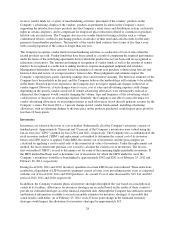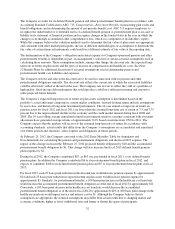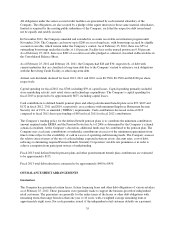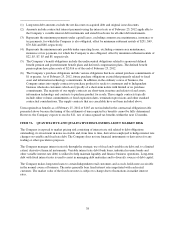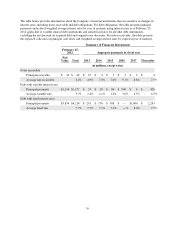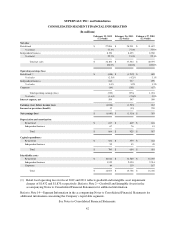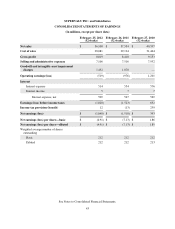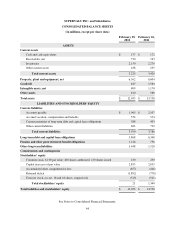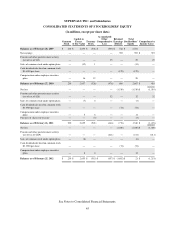Albertsons 2012 Annual Report Download - page 40
Download and view the complete annual report
Please find page 40 of the 2012 Albertsons annual report below. You can navigate through the pages in the report by either clicking on the pages listed below, or by using the keyword search tool below to find specific information within the annual report.the Company would be required to make payments under its guarantee. Generally, the guarantees are secured by
indemnification agreements or personal guarantees of the independent retail customer. The Company reviews
performance risk related to its guarantees of independent retail customers based on internal measures of credit
performance. As of February 25, 2012, the maximum amount of undiscounted payments the Company would be
required to make in the event of default of all guarantees was $108 and represented $80 on a discounted basis.
Based on the indemnification agreements, personal guarantees and results of the reviews of performance risk, the
Company believes the likelihood that it will be required to assume a material amount of these obligations is
remote. Accordingly, no amount has been recorded in the Consolidated Balance Sheets for these contingent
obligations under the Company’s guarantee arrangements.
The Company is contingently liable for leases that have been assigned to various third parties in connection with
facility closings and dispositions. The Company could be required to satisfy the obligations under the leases if
any of the assignees are unable to fulfill their lease obligations. Due to the wide distribution of the Company’s
assignments among third parties, and various other remedies available, the Company believes the likelihood that
it will be required to assume a material amount of these obligations is remote.
The Company is a party to a variety of contractual agreements under which the Company may be obligated to
indemnify the other party for certain matters, which indemnities may be secured by operation of law or
otherwise, in the ordinary course of business. These contracts primarily relate to the Company’s commercial
contracts, operating leases and other real estate contracts, financial agreements, agreements to provide services to
the Company and agreements to indemnify officers, directors and employees in the performance of their work.
While the Company’s aggregate indemnification obligation could result in a material liability, the Company is
not aware of any matters that are expected to result in a material liability.
Multiemployer Plans
The Company contributes to various multiemployer pension plans under collective bargaining agreements,
primarily defined benefit pension plans. These multiemployer plans generally provide retirement benefits to
participants based on their service to contributing employers. The benefits are paid from assets held in trust for
that purpose. Plan trustees typically are responsible for determining the level of benefits to be provided to
participants as well as the investment of the assets and plan administration. Trustees are appointed in equal
number by employers and unions parties to the collective bargaining agreement.
Expense is recognized in connection with these plans as contributions are funded, in accordance with generally
accepted accounting principles. The Company made contributions to these plans, and recognized expense, of
$130, $135 and $143 in 2012, 2011 and 2010, respectively. Company contributions to these plans could increase
in the near term. However, the amount of any increase or decrease in contributions will depend on a variety of
factors, including the results of the Company’s collective bargaining efforts, investment returns on the assets held
in the plans, actions taken by the trustees who manage the plans and requirements under the Pension Protection
Act and Section 412(e) of the Internal Revenue Code. Furthermore, if the Company was to significantly reduce
contributions, exit certain markets or otherwise cease making contributions to these plans, it could trigger a
partial or complete withdrawal that would require the Company to fund its proportionate share of a plan’s
unfunded vested benefits.
Based on the assessment of the most recent information available, the Company believes that most of the
multiemployer plans to which it contributes are underfunded. The Company is only one of a number of
employers contributing to these plans and the underfunding is not a direct obligation or liability of the Company.
However, the Company has attempted, as of February 25, 2012, to estimate its proportionate “share” of the
underfunding of multiemployer plans to which the Company contributes, based on the ratio of its contributions to
the total of all contributions to these plans in a year. As of February 25, 2012, the estimate of the Company’s
share of the underfunding of multiemployer plans to which it contributes was $1,679, pre-tax, or $1,034, after-
tax. This represents an increase in the estimated proportionate share of the underfunding of approximately
36




